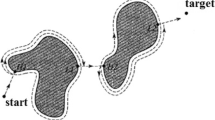Abstract
In this paper, a modified artificial potential field (MAPF) method was proposed for general mobile robot navigation system. This MAPF method can effectively solve the unreachable goal problem and the local minima problem of traditional APF method. The first key idea of MAPF method is to modify the repulsive force function and thus optimize the direction of total repulsive force; the second key idea is to generate a serials of subgoal points around obstacles with specific method, so as to help the robot escape from or keep away from local minima area. By comparing with other similar algorithms in simulation environment, the MAPF algorithm can generate shorter paths efficiently. More importantly, it also can generate effective paths in multi-obstacle environment where other algorithms cannot. Finally the simulation results verified the reasonability and practicability of the proposed MAPF method.
Access this chapter
Tax calculation will be finalised at checkout
Purchases are for personal use only
Similar content being viewed by others
References
Sombolestan, S.M., Rasooli, A., Khodaygan, S.: Optimal path-planning for mobile robots to find a hidden target in an unknown environment based on machine learning. J. Ambient. Intell. Humaniz. Comput. 10, 1841–1850 (2019). https://doi.org/10.1007/s12652-018-0777-4
Hart, P.E., Nilsson, N.J., Raphael, B.: A formal basis for the heuristic determination of minimum cost paths. IEEE Trans. Syst. Sci. Cybern. 4(2), 28–29 (1972)
Koenig, S., Likhachev, M.: Fast replanning for navigation in unknown terrain. IEEE Trans. Rob. 21(3), 354–363 (2005)
Khatib, O.: Real-time obstacle avoidance for manipulators and mobile robots. Int. J. Robot. Res. 5(1), 90–98 (1986)
Huang, Y., Hu, H., Liu, X.: Obstacles avoidance of artificial potential field method with memory function in complex environment. In: Proceedings of the 8th World Congress on Intelligent Control and Automation, pp. 6414–6418 (2010)
Qian, C., Qisong, Z., Li, H.: Improved artificial potential field method for dynamic target path planning in LBS. In: Proceedings of Chinese Control and Decision Conference (CCDC), pp. 2710–2714 (2018)
Fang, W., Fengyu, Z., Lei, Y.: Global path planning algorithm of mobile robot based on electric potential field. Robot. 41(6), 742–750 (2019)
Liang, X., Liu, C., Song, X., et al.: Research on improved artificial potential field approach in local path planning for mobile robot. Comput. Simul. 35(4), 291–361 (2018)
Wang, S., Zhao, T., Li, W.: Mobile robot path planning based on improved artificial potential field method. In: Proceedings of IEEE International Conference of Intelligent Robotic and Control Engineering (IRCE), pp. 29–33. IEEE (2018)
Chen, W., Wu, X., Lu, Y.: An improved path planning method based on artificial potential field for a mobile robot. Cybern. Inf. Technol. 15(2), 181–191 (2015)
Wang, D., Li, C., Guo, N., et al.: Local path planning of mobile robot based on artificial potential field. In: Proceedings of 39th Chinese Control Conference (CCC), pp. 25–30 (2021)
Acknowledgment
This work is mainly supported by National Key Research and Development Program of China (No. 2022YFB4702000) and Shenzhen Polytechnic Research Fund (6023310005K).
Author information
Authors and Affiliations
Corresponding author
Editor information
Editors and Affiliations
Rights and permissions
Copyright information
© 2023 The Author(s), under exclusive license to Springer Nature Singapore Pte Ltd.
About this paper
Cite this paper
Mo, J., Gao, C., Liu, F., Yang, Q., Fang, H. (2023). A Modified Artificial Potential Field Method Based on Subgoal Points for Mobile Robot. In: Yang, H., et al. Intelligent Robotics and Applications. ICIRA 2023. Lecture Notes in Computer Science(), vol 14267. Springer, Singapore. https://doi.org/10.1007/978-981-99-6483-3_26
Download citation
DOI: https://doi.org/10.1007/978-981-99-6483-3_26
Published:
Publisher Name: Springer, Singapore
Print ISBN: 978-981-99-6482-6
Online ISBN: 978-981-99-6483-3
eBook Packages: Computer ScienceComputer Science (R0)




